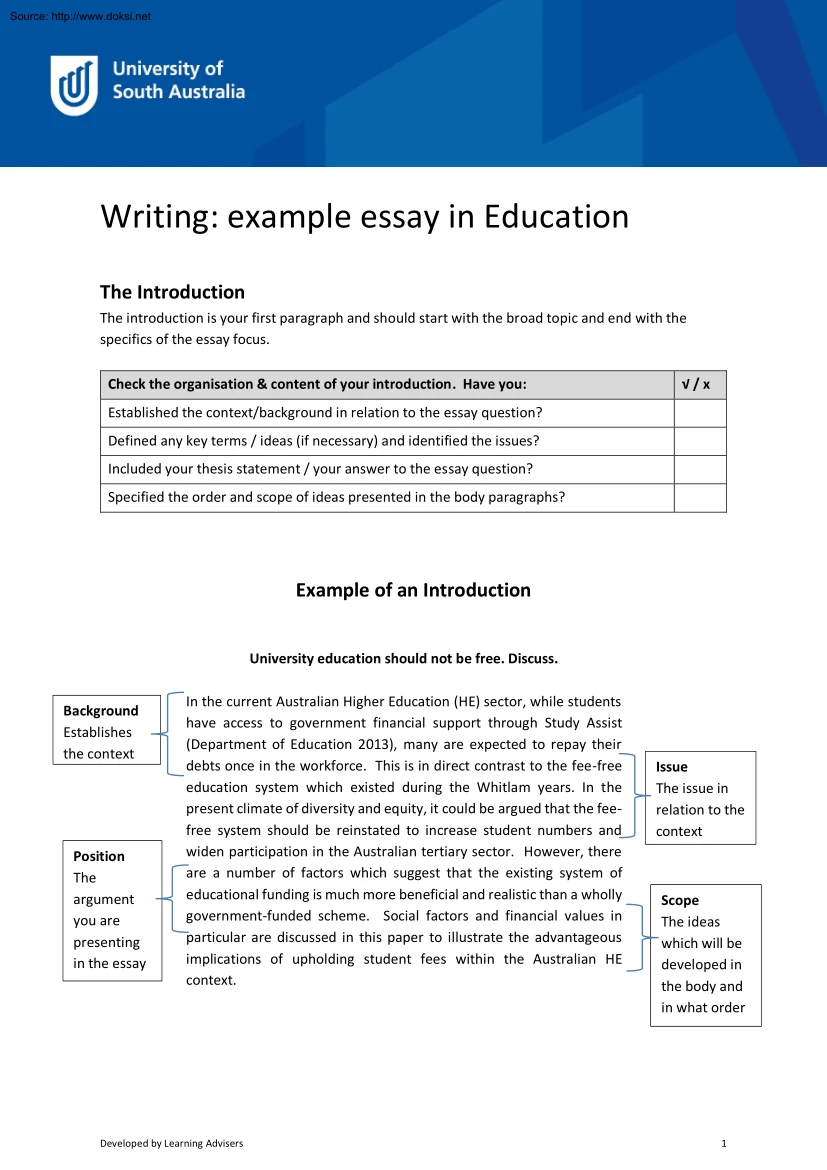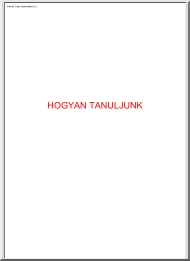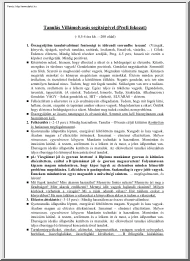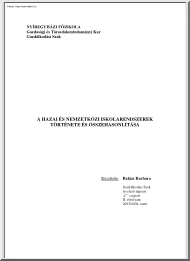Datasheet
Year, pagecount:2016, 4 page(s)
Language:English
Downloads:6
Uploaded:December 11, 2017
Size:777 KB
Institution:
-
Comments:
University of South Australia
Attachment:-
Download in PDF:Please log in!
Comments
No comments yet. You can be the first!Content extract
Source: http://www.doksinet Writing: example essay in Education The Introduction The introduction is your first paragraph and should start with the broad topic and end with the specifics of the essay focus. Check the organisation & content of your introduction. Have you: √/x Established the context/background in relation to the essay question? Defined any key terms / ideas (if necessary) and identified the issues? Included your thesis statement / your answer to the essay question? Specified the order and scope of ideas presented in the body paragraphs? Example of an Introduction University education should not be free. Discuss Background Establishes the context Position The argument you are presenting in the essay In the current Australian Higher Education (HE) sector, while students have access to government financial support through Study Assist (Department of Education 2013), many are expected to repay their debts once in the workforce. This is in direct contrast to the
fee-free education system which existed during the Whitlam years. In the present climate of diversity and equity, it could be argued that the feefree system should be reinstated to increase student numbers and widen participation in the Australian tertiary sector. However, there are a number of factors which suggest that the existing system of educational funding is much more beneficial and realistic than a wholly government-funded scheme. Social factors and financial values in particular are discussed in this paper to illustrate the advantageous implications of upholding student fees within the Australian HE context. Developed by Learning Advisers Issue The issue in relation to the context Scope The ideas which will be developed in the body and in what order 1 Source: http://www.doksinet The Body The purpose of each body paragraph is to support your thesis statement (answer to the essay question) through explanation and valid evidence/examples from academic readings. Does your
body paragraph include the following? √/x A topic sentence - This is a sentence which clearly indicates the focus of the paragraph. Development - These are sentences which explain and expand on your topic sentence, thesis and the essay question. Support - Use academic studies, research, expert voice, and/or theories as evidence to justify your thesis statement. These should be relevant and reliable - Integrate the support using your voice to show your interpretation. - Make it clear how the support relates to your topic sentence, your thesis statement, and/or the essay question. Referencing - Clearly reference other voices using the referencing system expected within your course. The reader should be able to see where your voice begins / ends and where other voices are included. An example of a body paragraph Support These sentences include evidence and/or examples to support the ideas which the writer presents. Note: all ideas in this paragraph are relevant to the topic sentence
and to the essay topic. Closing statement This sentence indicates that the writer will move on to a new paragraph and new focus. To begin with, it may be assumed that the predominant factor influencing a student’s choice to enrol at university is financial circumstance. Dobson and Birrell (1996, p 81) argue that this is particularly valid for students who are financially disadvantaged. If true, a free university education system might encourage a greater number of individuals from lower socio-economic groups to enrol, and thus increase student numbers across the HE sector. However, evidence suggests otherwise For example, with the introduction of HECS in 1989, where studying went from being free to accruing a cost, student numbers did not essentially decline; instead, they continued to grow (Andrews 1997, p. 4) This implies that enrolment numbers had not necessarily been affected by the re-introduction of student fees. Furthermore, other studies have indicated that factors which
are not costrelated can encourage or even discourage students to enrol. According to Birrell et. al (2000, p 51), such factors include peer pressure, family support, the perceived value of tertiary education and, inevitably, the state of the labour market. With this in mind, it is highly unlikely that the re-introduction of a free education will increase participation alone. Other factors such as social, family and general perception can motivate or demotivate individuals to study at tertiary level. Developed by Learning Advisers Topic Sentence The first sentence introduces the focus: influence of financial circumstance on uni enrolment. Development These sentences develop the idea introduced in the topic sentence. Note: the writer looks at both sides of the argument in this paragraph. This is because the essay instruction is to ‘discuss’ the topic. 2 Source: http://www.doksinet The Conclusion √/x Check the content of your conclusion. Have you: - referred back to the
essay question, your position & scope? - referred to ideas which were developed in the body? (and NOT included new information)? concluded with a statement which clearly shows your position/thoughts in relation to the overall topic? - An example of a conclusion In summary, while the notion of a free university system seems ideal, it is not realistic nor necessarily beneficial to the student or the institution as a whole. As mentioned, student motivation to study at tertiary level is more likely to be influenced by social rather than financial factors. In addition, students learn the values of saving and budgeting if they are required to pay for their studies. It is also noted that the current co-payment system in place, provides not only students with alternative payment options, but also provides the education sector with funding which would not exist otherwise. A feepaying university system is therefore vital to the growth and development of society at large. Topic Sentence
This sentence clearly shows that this paragraph is a conclusion by starting with ‘In summary’. It also restates the writer’s position (response to the essay question) Summary of ideas presented from body paragraph 1 (i.e social factors’ role in motivation to study) from body paragraph 2 (i.e learning to budget) from body paragraph 3 (i.e funding to the education sector) Conclusive statement This final sentence shows the writer’s overall argument that university education should not be free Essay example adapted from: Belmont W & Sharkey M, 2006, ‘The Easy Writer: formal writing for academic purposes’, Pearson Education Australia, NSW, pp311-319. Developed by Learning Advisers 3 Source: http://www.doksinet References Include a reference list at the end of your essay on a new page entitled References. Check your course outline to identify the referencing system you need to use. This Essay example uses the Harvard Referencing System (For guidance on
referencing, visit: www.unisaeduau/Referencing) Example of reference list References Note the following: Alphabetical order Single line spacing A space between each reference Full bibliographic details Specific formatting (spacing, use of punctuation, font style, etc) Developed by Learning Advisers Andrew, L 1997, The effects of HECS on interest in undertaking higher education, Australian Publishing Service, Canberra, Australia. Birrell, B, Calderon, A, Dobson, I, & Smith, T 2000, ‘Equity in access to higher education revisited’, People and Place, vol. 8, no 1, pp 50-60 Department of Education 2013, Study Assist, Department of Education, Australian Government, viewed 21 April 2014, <http://studyassist.govau/sites/StudyAssist/> Dobson, I, & Birrell, B 1996, ‘The impact of proposed changes to Austudy eligibility on higher education students, People and place, vol. 4, no 4, pp. 81-84 4
fee-free education system which existed during the Whitlam years. In the present climate of diversity and equity, it could be argued that the feefree system should be reinstated to increase student numbers and widen participation in the Australian tertiary sector. However, there are a number of factors which suggest that the existing system of educational funding is much more beneficial and realistic than a wholly government-funded scheme. Social factors and financial values in particular are discussed in this paper to illustrate the advantageous implications of upholding student fees within the Australian HE context. Developed by Learning Advisers Issue The issue in relation to the context Scope The ideas which will be developed in the body and in what order 1 Source: http://www.doksinet The Body The purpose of each body paragraph is to support your thesis statement (answer to the essay question) through explanation and valid evidence/examples from academic readings. Does your
body paragraph include the following? √/x A topic sentence - This is a sentence which clearly indicates the focus of the paragraph. Development - These are sentences which explain and expand on your topic sentence, thesis and the essay question. Support - Use academic studies, research, expert voice, and/or theories as evidence to justify your thesis statement. These should be relevant and reliable - Integrate the support using your voice to show your interpretation. - Make it clear how the support relates to your topic sentence, your thesis statement, and/or the essay question. Referencing - Clearly reference other voices using the referencing system expected within your course. The reader should be able to see where your voice begins / ends and where other voices are included. An example of a body paragraph Support These sentences include evidence and/or examples to support the ideas which the writer presents. Note: all ideas in this paragraph are relevant to the topic sentence
and to the essay topic. Closing statement This sentence indicates that the writer will move on to a new paragraph and new focus. To begin with, it may be assumed that the predominant factor influencing a student’s choice to enrol at university is financial circumstance. Dobson and Birrell (1996, p 81) argue that this is particularly valid for students who are financially disadvantaged. If true, a free university education system might encourage a greater number of individuals from lower socio-economic groups to enrol, and thus increase student numbers across the HE sector. However, evidence suggests otherwise For example, with the introduction of HECS in 1989, where studying went from being free to accruing a cost, student numbers did not essentially decline; instead, they continued to grow (Andrews 1997, p. 4) This implies that enrolment numbers had not necessarily been affected by the re-introduction of student fees. Furthermore, other studies have indicated that factors which
are not costrelated can encourage or even discourage students to enrol. According to Birrell et. al (2000, p 51), such factors include peer pressure, family support, the perceived value of tertiary education and, inevitably, the state of the labour market. With this in mind, it is highly unlikely that the re-introduction of a free education will increase participation alone. Other factors such as social, family and general perception can motivate or demotivate individuals to study at tertiary level. Developed by Learning Advisers Topic Sentence The first sentence introduces the focus: influence of financial circumstance on uni enrolment. Development These sentences develop the idea introduced in the topic sentence. Note: the writer looks at both sides of the argument in this paragraph. This is because the essay instruction is to ‘discuss’ the topic. 2 Source: http://www.doksinet The Conclusion √/x Check the content of your conclusion. Have you: - referred back to the
essay question, your position & scope? - referred to ideas which were developed in the body? (and NOT included new information)? concluded with a statement which clearly shows your position/thoughts in relation to the overall topic? - An example of a conclusion In summary, while the notion of a free university system seems ideal, it is not realistic nor necessarily beneficial to the student or the institution as a whole. As mentioned, student motivation to study at tertiary level is more likely to be influenced by social rather than financial factors. In addition, students learn the values of saving and budgeting if they are required to pay for their studies. It is also noted that the current co-payment system in place, provides not only students with alternative payment options, but also provides the education sector with funding which would not exist otherwise. A feepaying university system is therefore vital to the growth and development of society at large. Topic Sentence
This sentence clearly shows that this paragraph is a conclusion by starting with ‘In summary’. It also restates the writer’s position (response to the essay question) Summary of ideas presented from body paragraph 1 (i.e social factors’ role in motivation to study) from body paragraph 2 (i.e learning to budget) from body paragraph 3 (i.e funding to the education sector) Conclusive statement This final sentence shows the writer’s overall argument that university education should not be free Essay example adapted from: Belmont W & Sharkey M, 2006, ‘The Easy Writer: formal writing for academic purposes’, Pearson Education Australia, NSW, pp311-319. Developed by Learning Advisers 3 Source: http://www.doksinet References Include a reference list at the end of your essay on a new page entitled References. Check your course outline to identify the referencing system you need to use. This Essay example uses the Harvard Referencing System (For guidance on
referencing, visit: www.unisaeduau/Referencing) Example of reference list References Note the following: Alphabetical order Single line spacing A space between each reference Full bibliographic details Specific formatting (spacing, use of punctuation, font style, etc) Developed by Learning Advisers Andrew, L 1997, The effects of HECS on interest in undertaking higher education, Australian Publishing Service, Canberra, Australia. Birrell, B, Calderon, A, Dobson, I, & Smith, T 2000, ‘Equity in access to higher education revisited’, People and Place, vol. 8, no 1, pp 50-60 Department of Education 2013, Study Assist, Department of Education, Australian Government, viewed 21 April 2014, <http://studyassist.govau/sites/StudyAssist/> Dobson, I, & Birrell, B 1996, ‘The impact of proposed changes to Austudy eligibility on higher education students, People and place, vol. 4, no 4, pp. 81-84 4





